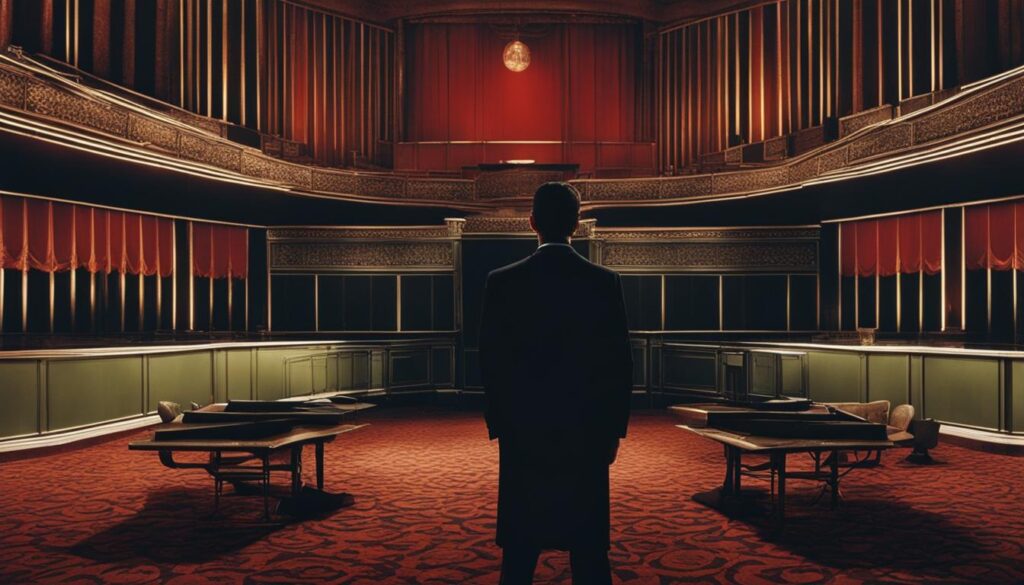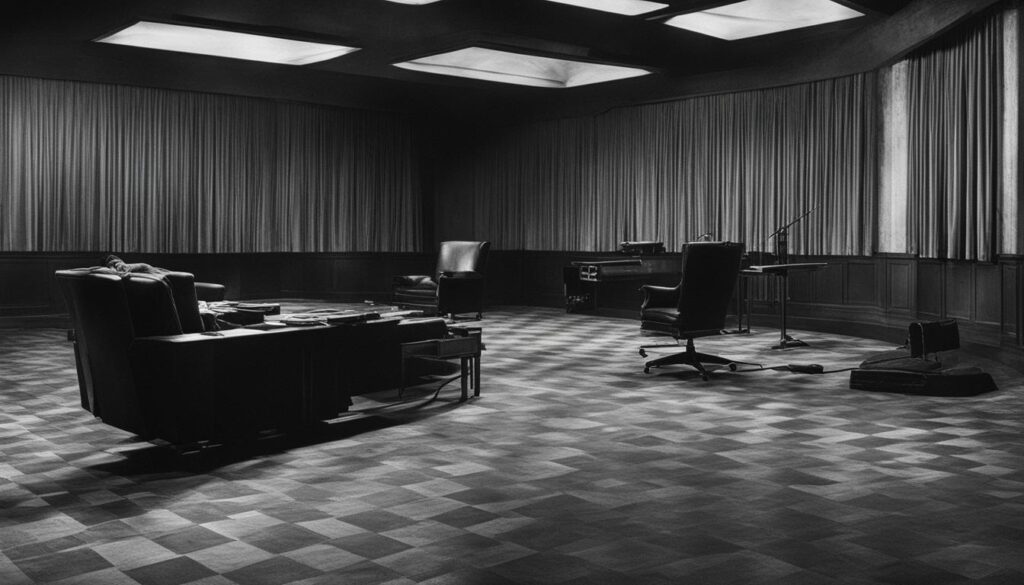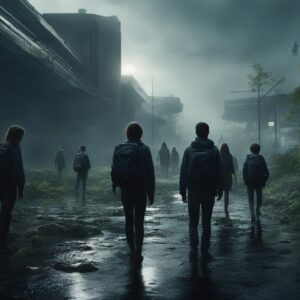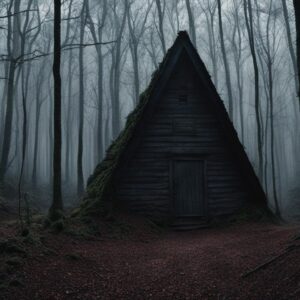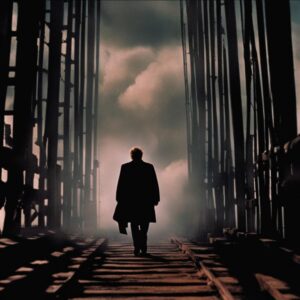Greetings, horror film enthusiasts! Today, I want to delve into the mesmerizing world of Japanese cinema and take a closer look at a truly unforgettable film, “Audition” (1999). Directed by the talented Takashi Miike, this Japanese horror masterpiece will leave you both fascinated and unsettled.
“Audition” takes viewers on a haunting journey into the depths of psychological terror, blurring the lines between reality and nightmare. It’s a film that will challenge your perceptions and linger in your thoughts long after the credits roll.
In this article, we will explore the slow-building sense of dread, the haunting performances, the disturbing blend of genres, and the powerful symbolism that makes “Audition” a standout in Japanese cinema. We’ll also discuss the legacy and controversy surrounding the film.
Key Takeaways:
- “Audition” (1999) is a Japanese horror film directed by Takashi Miike.
- The film explores psychological terror and blurs the lines between reality and nightmare.
- “Audition” captivates viewers with its slow-building sense of dread and unsettling atmosphere.
- The performances by Ryo Ishibashi and Eihi Shiina are haunting and memorable.
- The film’s blend of genres, including psychological horror and dark comedy, creates a unique and disorienting experience for viewers.
A Slow-Building Sense of Dread
“The Audition” offers a truly unsettling experience by masterfully building a slow-burning sense of dread. As the plot unfolds, the film takes its time, gradually drawing viewers deeper into a nightmarish world of horror and suspense. Through its deliberate pacing, “The Audition” creates an atmosphere of unease that lingers long after the credits roll.
The movie revolves around the auditions conducted by Aoyama, a widower seeking a new wife. What starts as a seemingly innocent process soon descends into a chilling exploration of obsession and sadism. The prolonged build-up intensifies the tension, heightening the impact of each disturbing revelation. This deliberate approach allows the audience to experience the growing unease alongside the characters.
“The Audition” captivates audiences with its slow and deliberate pacing, gradually building an ever-increasing sense of dread.
Uncovering the layers of horror
The plot of “The Audition” is meticulously crafted to keep viewers on the edge of their seats. The slow revelation of the dark secrets and twisted intentions of the characters adds to the escalating suspense. Each scene is meticulously constructed to maximize the impact of the horror, immersing the audience in a chilling and twisted narrative.
The film’s plot twists and turns amplify the sense of dread and unpredictability. As the layers of deception are peeled away, the audience is forced to confront the disturbing reality that lies beneath the surface. “The Audition” keeps audiences guessing until the very end, ensuring a truly harrowing experience.
The power of suggestion and anticipation
Takashi Miike’s direction in “The Audition” is masterful in creating an atmosphere of impending doom and discomfort. The skillful use of silence, shadows, and carefully crafted shots instills a sense of unease in the audience. The anticipation of what might happen next becomes almost unbearable, heightening the overall sense of dread.
By skillfully manipulating the audience’s expectations and exploiting their fears, “The Audition” delivers an unforgettable experience. The slow-burning horror and mounting tension make it a standout example of the horror genre, leaving a lasting impression on all who dare to watch.
Haunting Performances and Complex Characters
The cast of “The Audition” delivers haunting performances that bring the complex characters to life. Ryo Ishibashi shines in the role of Aoyama, the widower searching for a new wife. His portrayal is both vulnerable and captivating, as he navigates the dark and twisted path that unfolds before him. Ishibashi’s ability to convey the inner turmoil of his character adds depth to the narrative and leaves a lasting impression on viewers.
Eihi Shiina is equally mesmerizing as Asami, the enigmatic woman who auditions for Aoyama’s affections. With her subtle gestures and piercing gaze, Shiina embodies the unsettling nature of her character, making her presence felt in every scene. Asami’s unpredictability and quiet intensity make her one of the most memorable characters in Japanese horror cinema.
The chemistry between Ishibashi and Shiina is palpable, their performances complementing and enhancing each other. The nuanced interactions between Aoyama and Asami create a sense of unease and tension that lingers throughout the film. The actors’ commitment to their roles and their ability to convey complex emotions make “The Audition” a truly captivating and disturbing experience.
With their haunting performances, Ryo Ishibashi and Eihi Shiina bring depth and complexity to the characters in “The Audition,” adding layers of intrigue and leaving audiences unsettled long after the credits roll.
The Cast of “The Audition”
| Actor | Character |
|---|---|
| Ryo Ishibashi | Aoyama |
| Eihi Shiina | Asami |
A Disturbing Blend of Genres
“The Audition” is a Japanese horror film that defies traditional genre boundaries, seamlessly blending elements of psychological horror and dark comedy. This unique combination creates a disorienting and unsettling experience for viewers, challenging their expectations and leaving a lasting impression.
In “The Audition,” director Takashi Miike masterfully crafts a narrative that begins innocuously enough with a widower’s search for love through an unconventional audition process. However, as the story unfolds, it descends into a nightmarish exploration of obsession, power dynamics, and the darkest recesses of the human psyche. Through its expertly crafted suspense and carefully placed moments of dark humor, the film creates a sense of unease that lingers long after the credits roll.
The juxtaposition of psychological horror and dark comedy in “The Audition” serves to enhance the impact of both genres. The moments of humor provide a brief respite from the tension, only to be swiftly followed by scenes that push the boundaries of what is considered acceptable or comfortable. This constant shifting of tone adds to the overall sense of unease and keeps viewers on the edge of their seats.
The Unsettling Effects of Genre Blending
By seamlessly blending psychological horror and dark comedy, “The Audition” challenges traditional storytelling conventions and invites viewers to question their own expectations of the genre. It subverts the familiar tropes of horror films and creates a unique and unsettling experience that is at once disturbing, thought-provoking, and strangely captivating.
| Genre | Characteristics |
|---|---|
| Psychological Horror | Explores the inner workings of the human mind, delving into themes of fear, paranoia, and psychological torment. |
| Dark Comedy | Makes use of humor to address uncomfortable or taboo subjects, often presenting a satirical take on societal norms and expectations. |
By navigating the murky waters between these two genres, “The Audition” not only delivers a terrifying and unsettling experience, but also provokes deeper reflection on the nature of fear, desire, and the lengths some individuals will go to in pursuit of their desires. It is this disturbing blend of genres that sets “The Audition” apart from other horror films and solidifies its place as a unique and unforgettable entry in the pantheon of Japanese cinema.
Symbolism and Interpretation
The film “Audition” is rich with symbolism, inviting viewers to delve deep into its layers of meaning and interpretation. Director Takashi Miike masterfully uses visual cues and metaphorical elements to enhance the overall impact of the film. From the haunting imagery to the subtle details, every frame is carefully constructed to convey a deeper message.
One of the most prominent symbols in “Audition” is the use of a needle and thread. This recurring motif represents the idea of control and manipulation. Asami, the enigmatic character, is often seen sewing, symbolizing her desire to exert power over others. The needle and thread also evoke themes of vulnerability and pain, as they are used to inflict harm on the unsuspecting victims. Through this symbol, the film explores the destructive nature of obsession and the consequences it can have.
Symbolism in “Audition” opens the door to various interpretations, sparking discussions among viewers and film enthusiasts. It adds depth and complexity to the narrative, allowing for personal reflections and different understandings of the story.
Another symbol that pervades the film is the empty sack. This represents the emptiness and longing within the characters, particularly Aoyama. The sack is a visual representation of his search for happiness and fulfillment. As the film progresses, the sack becomes more prominent, mirroring Aoyama’s increasing desperation and the darkness that lurks beneath his seemingly normal facade.
The use of symbolism in “Audition” extends beyond visual elements. The sound design also contributes to the overall atmosphere and meaning of the film. The eerie sound of the ringing telephone, for example, serves as a foreboding premonition of the horror that is about to unfold. The juxtaposition of seemingly innocent sounds with the increasingly disturbing events adds an extra layer of tension and unease.
Symbolism in “Audition”: A Closer Look
Examining the symbolism in “Audition” allows for a deeper understanding of the film’s themes and messages. It prompts viewers to question societal norms, explore the complexities of human relationships, and reflect on the consequences of unchecked desires. The use of symbolism not only enhances the viewing experience but also invites a more profound engagement with the film’s underlying themes.
Masterful Direction and Atmosphere
When it comes to creating suspense and an unsettling atmosphere, Takashi Miike’s direction in “The Audition” is nothing short of masterful. Every scene is meticulously crafted to build tension and evoke a sense of unease that lingers long after the film ends.
From the opening shots to the film’s climactic moments, Miike’s attention to detail is evident. He expertly uses lighting, camera angles, and pacing to heighten the sense of dread, keeping viewers on the edge of their seats. Whether it’s a close-up of a character’s face or a slow tracking shot through a dimly lit room, every visual choice serves to enhance the film’s unsettling tone.
The atmosphere of “The Audition” is further intensified by the haunting musical score. From its eerie melodies to its jarring sound effects, the music adds an additional layer of discomfort and unease. Combined with Miike’s masterful direction, the score contributes to the overall sense of dread that permeates the film.
It is through the combination of Miike’s meticulous direction and the film’s atmospheric elements that “The Audition” succeeds in creating a truly chilling viewing experience. The suspense is palpable, and the atmosphere is unrelenting, leaving a lasting impact on audiences.
The Power of Suspense
Suspense is a powerful tool in filmmaking, and Takashi Miike demonstrates his command of it in “The Audition.” By carefully controlling the flow of information and strategically revealing key plot points, Miike keeps viewers engaged and invested in the story.
Throughout the film, Miike gradually builds suspense, creating a constant sense of anticipation. He expertly balances moments of calm with sudden shocks and surprises, leaving audiences on edge and unsure of what will happen next.
This skillful use of suspense not only keeps viewers engaged, but it also amplifies the impact of the film’s more disturbing and intense moments. By raising the stakes and heightening the tension, Miike ensures that the audience is fully immersed in the terror unfolding on screen.
Creating an Unsettling Experience
In addition to his mastery of suspense, Takashi Miike carefully crafts an unsettling experience for viewers in “The Audition.” Through the film’s cinematography, sound design, and disturbing imagery, Miike pulls audiences into a world that is as disturbing as it is captivating.
The cinematography in “The Audition” is striking and purposeful. Miike uses various techniques, such as extreme close-ups and unconventional camera angles, to create a sense of unease and disorientation. These choices immerse viewers in the characters’ perspective, making them uncomfortably complicit in the unfolding horror.
The sound design further amplifies the film’s unsettling nature. From the subtle sounds of footsteps to the spine-chilling score, every auditory element is carefully selected to enhance the atmosphere and evoke a visceral response from the audience.
The combination of Miike’s masterful direction, the power of suspense, and the creation of an unsettling experience makes “The Audition” a standout example of psychological horror. It is a film that leaves viewers with a lasting sense of unease and a deep appreciation for the artistry of Takashi Miike.
Disturbing and Graphic Territory
“The Audition” delves into disturbing and graphic territory, pushing the boundaries of horror and challenging the sensibilities of viewers. The film’s unflinching portrayal of violence and sadism leaves a lasting impression, evoking a profound sense of discomfort and unease.
The graphic scenes in “The Audition” serve a crucial purpose in conveying the psychological depths of the characters and exploring the darkest recesses of the human psyche. Director Takashi Miike’s unrelenting approach exposes the brutal reality that lies beneath the surface of societal norms and expectations.
The film’s intense and disturbing moments, while unsettling, serve as a catalyst for thought-provoking discussions about power dynamics, obsession, and the consequences of unchecked desires. “The Audition” forces viewers to confront uncomfortable truths and challenges them to question their own perceptions of what is acceptable and ethical.
Disturbing Scenes that Provoke Reflection
“The Audition” is not for the faint of heart. Its graphic scenes are intentionally designed to provoke a strong emotional reaction and leave a lasting impact on the viewer. They serve as a reflection of the darker aspects of human nature and the lengths to which individuals are willing to go in pursuit of their desires. The film’s disturbing content may be too intense for some, but it boldly pushes boundaries and challenges conventional storytelling, making it a memorable and thought-provoking experience.”
The Controversy Surrounding “The Audition”
Due to its explicit and disturbing content, “The Audition” has generated controversy since its release. The film’s unflinching portrayal of violence and sadism has sparked debates about the moral responsibility of artists and the boundaries of artistic expression. While some argue that the film goes too far in its depiction of brutality, others view it as a necessary exploration of the human condition and its darker aspects.
Regardless of one’s stance on the controversy, “The Audition” remains a powerful and unforgettable cinematic experience. Its disturbing and graphic scenes challenge viewers to confront uncomfortable truths about human nature and the lengths to which individuals are willing to go in pursuit of their desires.
Takashi Miike’s Magnum Opus
When it comes to the world of Japanese cinema, few directors have left as indelible a mark as Takashi Miike. Known for his boundary-pushing and provocative films, Miike’s work has consistently pushed the limits of storytelling and challenged conventional norms. And within his vast filmography, one standout masterpiece continues to captivate audiences: “Audition” (1999).
With its haunting exploration of psychological terror, “Audition” stands as a testament to Miike’s artistry and his ability to craft a truly unsettling experience. The film’s slow-building sense of dread, combined with the mesmerizing performances of Ryo Ishibashi and Eihi Shiina, creates a narrative that lingers long after the credits roll.
What sets “Audition” apart is its ability to seamlessly blend genres. It moves effortlessly between psychological horror, mystery, and dark comedy, creating a disorienting and unforgettable film. Miike’s masterful direction and attention to detail contribute to the film’s overall atmosphere, amplifying the unease and suspense.
“Audition” is a testament to the enduring power of unconventional storytelling and the impact it can have on audiences. It solidifies Takashi Miike’s reputation as a master of horror and cements its place as a masterpiece of Japanese cinema.
As we delve deeper into the legacy and impact of “Audition,” it becomes clear that this film is not just a horror movie; it is a work of art that continues to challenge and provoke viewers. Its exploration of themes like obsession, deception, and the darkest depths of the human psyche leaves a lasting impression, underscoring the film’s significance in contemporary cinema.
To truly appreciate “Audition,” one must embrace the unconventional storytelling and fearless narrative choices that Miike employs. It is a film that demands multiple viewings and invites interpretation. Whether it’s dissecting the symbolism within the imagery or examining the psychological depths of the characters, “Audition” offers a rich tapestry for analysis and discussion.
So, take a seat, prepare to be unsettled, and enter the world of “Audition.” It is an experience that will forever remain etched in your memory and a testament to the enduring power of Takashi Miike’s magnum opus.
J-horror’s Impact: Audition’s Influence on Unconventional Narrative
When it comes to the genre of J-horror, few films have had as significant an impact as “Audition.” This unsettling masterpiece by Takashi Miike challenged the conventions of horror storytelling and left audiences captivated by its unconventional narrative approach. With its exploration of psychological depths and its fearless examination of character psychologies, “Audition” paved the way for a new wave of genre-bending films.
One of the most remarkable aspects of “Audition” is its ability to blur the lines between reality and nightmare. The film takes audiences on a haunting journey, gradually building a sense of dread that lingers long after the credits roll. This slow-building tension and suspense create a truly immersive and unnerving experience, setting “Audition” apart from traditional horror films.
“Audition” challenged mainstream horror’s predictable patterns with its unconventional narrative approach and fearless exploration of character psychologies. It opened the door for other filmmakers to push the boundaries of the genre and experiment with storytelling techniques.
The impact of “Audition” goes beyond the boundaries of J-horror, reaching a global audience and inspiring filmmakers around the world. Its influence can be seen in films that explore similar themes of psychological terror, obsession, and the macabre. By breaking free from traditional narrative structures and embracing the dark, unsettling aspects of human nature, “Audition” forever changed the landscape of horror cinema.
Unmasking Deception and Obsession
In “The Audition,” deception and obsession are central themes that unravel throughout the film, exposing the dark underbelly of human nature. Director Takashi Miike masterfully delves into the destructive implications of unhealthy infatuation, challenging societal norms and the objectification of others.
The film’s protagonist, Aoyama, becomes ensnared in a web of deceit as he seeks a new wife through a twisted audition process. As the plot unfolds, the line between reality and fantasy blurs, revealing the depths of Aoyama’s obsession and the true nature of the mysterious woman, Asami.
This exploration of deception and obsession serves as a cautionary tale, highlighting the dangers of idolization and the consequences of repressed emotions. It confronts viewers with uncomfortable truths about human desires and the lengths some individuals will go to satisfy their obsessions.
As Aoyama discovers the truth behind Asami’s past and her disturbing desires, the film forces us to question our own perceptions and the masks we wear in our daily lives.
Through its unsettling narrative and thought-provoking themes, “The Audition” forces us to confront the complexities of human relationships and the darkness that resides within us all. It is an unnerving journey that will linger in the psyche long after the credits roll.
Psychological Depths and Interpretations
As a psychological thriller, “The Audition” invites viewers to delve into the complex depths of the human psyche. The film pulsates with an eerie atmosphere and an unsettling sense of unease, leaving audiences captivated and disturbed. Its narrative unfolds like a psychological labyrinth, offering multiple interpretations and sparking endless discussions.
One interpretation of “The Audition” revolves around its exploration of gender norms and societal expectations. The character of Asami represents the suppressed desires and frustrations of women in a male-dominated society, unleashing her fury in a horrifying act of revenge. This perspective highlights the film’s critique of patriarchal structures and the consequences of repressed emotions.
Another analysis of “The Audition” focuses on the cyclical nature of violence and abuse. Aoyama’s obsession and idealization of Asami mirrors a pattern seen in real-life abusive relationships. The film delves into the darkness of the human psyche, unmasking the destructive implications of unchecked desire and obsession.
Furthermore, “The Audition” serves as a cautionary tale about the dangers of objectification and idealization. Aoyama’s relentless pursuit of the perfect woman leads to his downfall, as his fantasies are shattered by the chilling reality of Asami’s true nature. The film serves as a stark reminder that the search for an idealized image can lead to betrayal, deception, and even violence.
Interpretations of “The Audition”
“The Audition” is a chilling exploration of the human psyche, offering deep and thought-provoking interpretations. It forces us to confront uncomfortable truths about gender dynamics, the cycle of violence, and the dangers of objectification. By delving into these psychological depths, the film leaves a lasting impact on its viewers.”
– Film Critic
Crafting a Horrifying Experience
The cinematography, music, and sound design in “The Audition” play a crucial role in creating a truly horrifying and unsettling experience for the audience. From the very beginning, the visual style sets the tone for the impending terror, with its use of muted colors and stark lighting. Each frame is meticulously composed to evoke a sense of unease, drawing viewers deeper into the nightmarish world of the film.
The camera work in “The Audition” is both subtle and calculated, heightening the suspense and amplifying the impact of key moments. Wide shots are used to establish a sense of isolation and vulnerability, while close-ups intensify the emotional turmoil of the characters. The camera movements are deliberate and precise, guiding the audience’s gaze and building tension as the story unfolds.
The haunting musical score of “The Audition” adds another layer of horror to the film, perfectly complementing the visuals and heightening the sense of dread. The music, composed by Kôji Endô, is both ethereal and dissonant, further immersing viewers in the unsettling atmosphere of the film. The sound design further enhances the chilling experience, with subtle yet impactful audio cues that leave a lasting impression.
The combination of exceptional cinematography, a haunting musical score, and meticulous sound design work in harmony to create a truly terrifying and unforgettable cinematic experience in “The Audition”. These elements elevate the horror genre to new heights, leaving audiences captivated and disturbed long after the credits roll.
The Audition: Crafting a Horrifying Experience
| Aspect | Description |
|---|---|
| Cinematography | Meticulously composed frames, muted colors, and stark lighting |
| Camera Work | Subtle and calculated movements, wide shots for isolation, close-ups for emotional impact |
| Music | Haunting and dissonant score by Kôji Endô, enhancing the unsettling atmosphere |
| Sound Design | Subtle yet impactful audio cues, heightening the sense of horror |
Legacy and Controversy
Takashi Miike’s “The Audition” has left an indelible mark on the world of horror cinema, cementing its place as a modern classic. Released in 1999, this Japanese film continues to captivate audiences with its exploration of psychological terror and its unflinching portrayal of dark themes.
“The Audition” is a masterpiece that pushes the boundaries of what horror cinema can achieve. Its disturbing and graphic scenes challenge viewers, sparking both acclaim and controversy. The explicit portrayal of violence and the exploration of taboo subjects have divided audiences, but it is precisely this boldness that has contributed to its enduring legacy.
The film’s legacy extends beyond its initial release, influencing a new generation of filmmakers and shaping the landscape of horror cinema. Takashi Miike’s meticulous direction and his ability to craft a haunting atmosphere continue to inspire and awe aspiring directors.
Despite its controversial nature, “The Audition” remains a testament to the power and impact of boundary-pushing storytelling. It is a film that demands attention, provokes discussion, and challenges our understanding of horror, leaving a lasting impression on all who experience its unnerving beauty.
| Legacy | Controversy |
|---|---|
| The film is regarded as a masterpiece of Japanese cinema and has solidified Takashi Miike’s reputation as a master of horror. | The explicit portrayal of violence and controversial themes have sparked debates among audiences and critics. |
| It continues to influence and inspire filmmakers, expanding the boundaries of the horror genre. | Some viewers have criticized the film for its disturbing content and graphic nature. |
| Its exploration of psychological terror and its blend of genres have made it a landmark film. | Despite controversy, “The Audition” has garnered critical acclaim for its unique storytelling. |
Conclusion
As a film critic and avid fan of Japanese cinema, I cannot emphasize enough the impact and enduring power of “The Audition.” This unforgettable film, directed by Takashi Miike, is a masterpiece that continues to captivate audiences and solidify its place in the annals of Japanese cinema.
From the slow-building sense of dread to the haunting performances of Ryo Ishibashi and Eihi Shiina, “The Audition” delivers an unparalleled viewing experience. Miike’s masterful direction, coupled with the film’s disturbing blend of genres, creates an atmosphere that is both unsettling and mesmerizing.
Symbolism abounds throughout the film, allowing for multiple interpretations and engaging discussions among viewers. This, coupled with the meticulously crafted cinematography and haunting musical score, enhances the overall impact of “The Audition” and ensures its place as an iconic work of art.
In conclusion, “The Audition” is an unforgettable and thought-provoking film that pushes the boundaries of psychological terror. Its exploration of deception, obsession, and the darkest depths of the human psyche makes it a must-watch for any fan of Japanese cinema. Prepare to be captivated, disturbed, and left with a lingering sense of unease long after the credits roll.
FAQ
What is “The Audition”?
“The Audition” is a Japanese horror film directed by Takashi Miike. It is known for its psychological terror and exploration of dark themes.
What is the plot of “The Audition”?
The film revolves around a middle-aged widower’s unconventional audition process to find a new wife. However, this audition quickly descends into a nightmarish spiral of obsession and sadism.
Who are the main actors in “The Audition”?
Ryo Ishibashi plays the widower, Aoyama, and Eihi Shiina portrays Asami, the enigmatic woman who auditions for his affections.
What genres does “The Audition” blend?
“The Audition” combines elements of psychological horror, mystery, and dark comedy, creating a unique and unsettling viewing experience.
Are there symbolic elements in “The Audition”?
Yes, the film is rich with symbolism, allowing for multiple interpretations and discussions among viewers. Symbolism adds depth to the narrative and enhances its impact.
How is the directing in “The Audition”?
Director Takashi Miike demonstrates mastery of suspense and atmosphere. Meticulously crafted scenes and a haunting musical score heighten the film’s unsettling tone and sense of unease.
Is “The Audition” a disturbing film?
Yes, “The Audition” explores disturbing and graphic territory, delving into themes of obsession, power dynamics, and the darkest recesses of the human psyche.
What impact did “The Audition” have on Japanese cinema?
“The Audition” is considered one of Takashi Miike’s most significant films and has had a genre-expanding impact. It challenged mainstream horror with its unconventional narrative approach and exploration of character psychologies.
What themes does “The Audition” explore?
“The Audition” delves into themes of deception, obsession, cycles of violence, and the dangers of objectification and idealization.
How is the cinematography and sound design in “The Audition”?
The cinematography, music, and sound design contribute to the film’s horrifying experience. The visual style evolves with the tension, while the music and sounds enhance the unsettling atmosphere.
What is the legacy of “The Audition”?
“The Audition” solidified Takashi Miike’s reputation as a master of horror and generated acclaim and controversy due to its explicit violence and exploration of dark themes.


